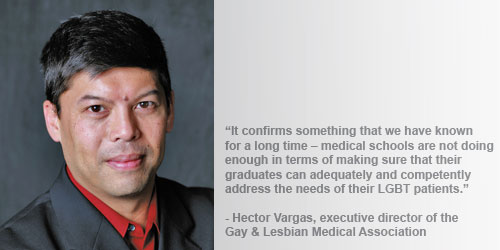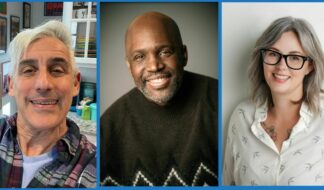By Bob Roehr

U.S. and Canadian medical schools offer a median of only five hours of training on meeting the needs of LGBT patients, according to a survey published in the Sept. 7 issue of JAMA, the Journal of the American Medical Association.
A third of the responses indicated that the school provided no training on LGBT health, while the average response was seven hours.
Nearly all – 97 percent – reported that students are taught "to ask patients if they have sex with men, women, or both when obtaining a sexual history."
The difference between behavior and identity (i.e. men who have sex with men versus gay) was taught by 72 percent of the schools, while 21.2 percent did not know if the issue was addressed.
Most deans rated their school's coverage of LGBT content as "fair" (58 schools; 43.9 percent), with the balance splitting fairly evenly between "very good" or "good" (32; 24.2 percent) and "very poor" or "poor" (34: 25.8 percent).
"This indicates dissatisfaction with medical school coverage of LGBT content at a number of schools, especially given the expected positive skew associated with survey self-reporting, and suggests room for improvement in LGBT-related curricula," the authors concluded.
The 13-question web-based survey was designed to take 15 minutes to complete. It was sent to the deans of all 176 medical schools in the U.S. and Canada. The response rate was strong, with 150 surveys returned and 132 fully completed.
Stanford University medical school professor Juno Obedin-Maliver was the lead author of the paper.
It is likely that this survey captures an optimistic view of the situation. Research suggests that persons favorably disposed to a topic are more likely to respond to a survey on it, while those who view the topic less favorably are less likely to respond.
In April the Institute of Medicine issued a report on research issues for LGBT health, which did not address training for healthcare workers. However, Robert Graham, the chair of the committee that wrote the report, expected that the extensive literature in the field that they gathered and published would "help medical schools develop curriculum" in much the same way that a 1980s report on black and minority health did.
Reactions
"The 85-percent response rate alone is indicative of a high level of interest" by the medical school deans, wrote Raymond Curry in an accompanying editorial. He teaches at Northwestern University medical school.
He wondered what the survey might have missed, such as discussion of same-sex aspects in a presentation on sexually transmitted infections, or during clinical rounds when a patient might happen to be gay.
"It would have been valuable to know the extent to which survey respondents are aware of teaching faculty who identify themselves as LGBT, of the degree to which student LGBT groups are part of the mainstream of student organizations at the school, and any other evidence that the institutional culture is seen as welcoming," Curry added.
The report is important because "it highlights the deficits in medical education related to sexual orientation and gender minority population," said Kenneth Mayer with Fenway Community Health in Boston. Healthcare providers play a key role in helping LGBT individuals access the support and services they need and deserve.
"JAMA is one of the most widely read medical journals, and it rejects a majority of articles submitted to it," he explained. "Publication suggests that the editors appreciate the need for medical education to be more responsive to the health concerns of sexual and gender minority populations."
"Many of us know that access to culturally competent care is a fundamental human right, so it is gratifying to see rigorous medical publications implicitly endorsing this perspective," Mayer said.
Additional data
Hector Vargas, executive director of the Gay and Lesbian Medical Association, said they worked with the researchers in putting together the survey. "It is good to finally see the results."
"It confirms something that we have known for a long time – medical schools are not doing enough in terms of making sure that their graduates can adequately and competently address the needs of their LGBT patients."
GLMA and the American Medical Association conducted a survey of physicians, not yet published, that complements the survey of medical schools.
"It found that 40 percent of physicians who participated in the survey had no formal training whatsoever (in dealing with LGBT patients), including medical school, residency and continuing education programs," Vargas said.
Half said they received five hours of training or less. And 56 percent of those who did receive training said "it was not very or not at all useful in their practice."
"We have a long way to go to make sure that needs of LGBT patients are being addressed in clinical settings," Vargas said.
He did not know if the situation has improved among physicians who were trained more recently. While society, and particularly younger persons, have become more accepting of gays, medical schools often "have yet to embrace that and make it part of their curriculum."
He pointed to the large integrated healthcare provider Kaiser Permanente as being a leader in this area. It has developed a program and training manual on LGBT issues for its employees.
The Department of Health and Human Services has taken steps to better include LGBT concerns in most areas of its operations. Vargas said, "If health professionals schools do not step up, we are going to continue to see a gap in meeting those needs."










